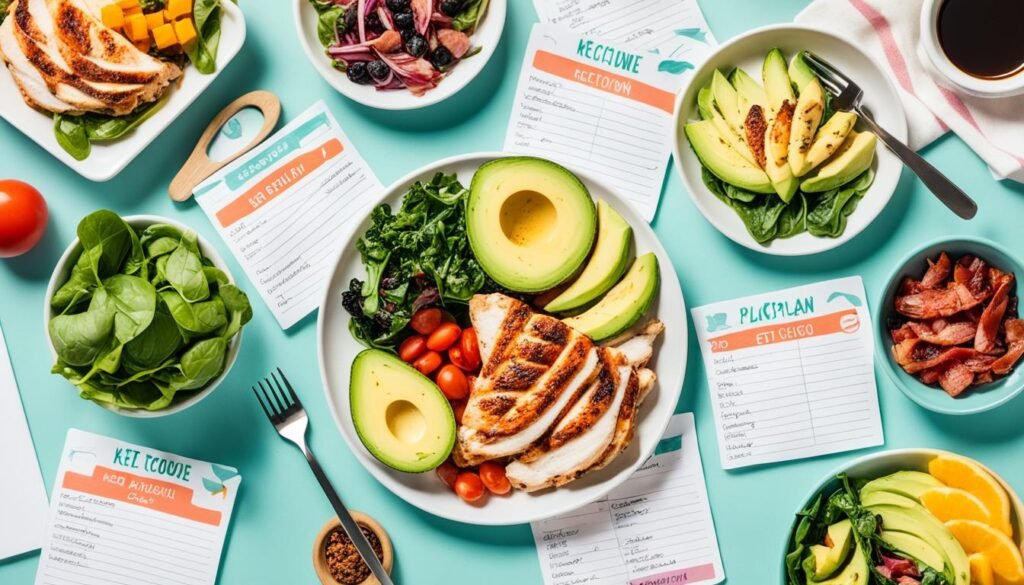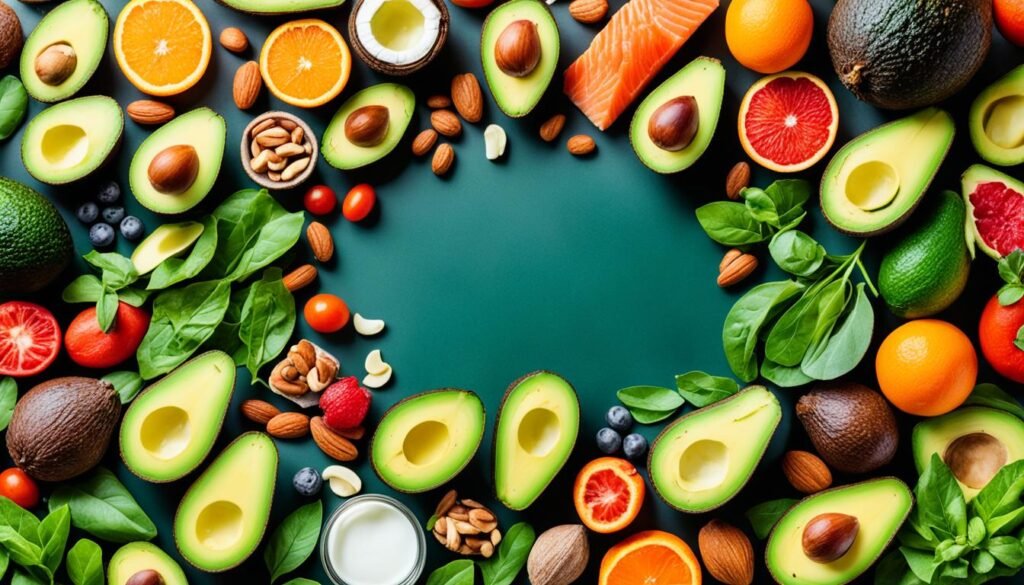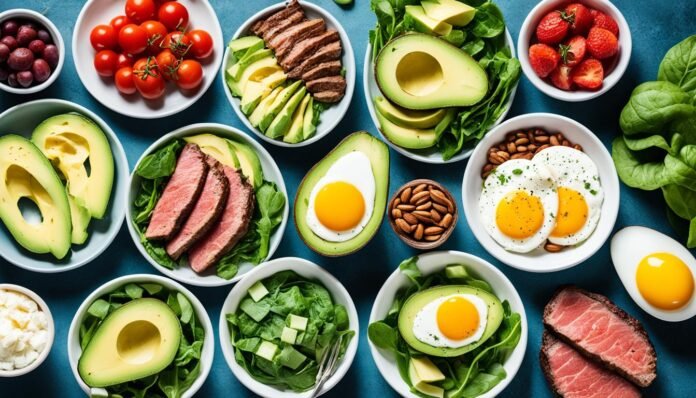Switching to a keto diet means eating more fats, moderate protein, and fewer carbs. This change puts your body in a state called ketosis. Here, it burns fat for energy instead of carbs. A customized ketosis meal plan makes this switch easier and boosts your health benefits. This plan is perfect for those wanting a diet that’s structured.
Choosing a personalized plan can help you lose weight and feel better overall. It creates a meal plan just for your body’s needs, removing the guesswork. Start a customized meal plan and see how you reach your health goals.
Introduction to the Keto Diet
The ketogenic diet, or keto diet, cuts down on carbs and ups fat intake. This switches the body’s main energy source from glucose to fats. This process, called ketosis, turns fat into energy efficiently. The diet is popular for its health benefits and weight loss effects.
What is the Keto Diet?
The keto diet means you eat far fewer carbs and more fats. This switch makes the body burn fat for energy. It leads to weight loss, boosts energy, and promotes well-being. Cutting carbs helps keep blood sugar levels stable, which is great for those with insulin issues.
Benefits of the Keto Diet
The keto diet offers more than weight loss. It can enhance mental focus, lessen inflammation, and may cut the risk of chronic diseases. Eating healthy fats boosts heart health and energy all day. The keto diet also helps in diabetes management by focusing on low-carb foods.
Common Misconceptions about the Keto Diet
Some people misunderstand the keto diet. Not all fats are bad. It’s important to eat healthy fats like those in avocados, nuts, and olive oil. Another myth is that the diet causes nutrient shortages. But, with careful meal planning, it can be nutritious and satisfying. Knowing the facts helps you see the real benefits of this low-carb diet.
How to Start Your Ketosis Meal Plan
Starting your ketosis meal plan requires a careful approach. To succeed, you should outline your goals, plan accordingly, and find support.
Setting Realistic Goals
Before starting your keto diet, it’s important to set realistic goals. Think about your health, lifestyle, and what you want to achieve. Goals should be more than losing weight; they should enhance your well-being too. Make sure your goals are clear, reachable, and have a deadline. This will help you stay motivated.
Create a Custom Keto Meal Plan
Creating a custom keto plan means knowing your nutritional needs. Start by figuring out your fat, protein, and carb needs. Then choose foods that match these needs and you enjoy.
Meal prep is also key. Preparing your meals ahead can save time and keep you on track.

Finding an Accountability Partner
Having someone to support you on your keto journey is crucial. This can be a friend, family member, or coach. They offer motivation, support, and guidance.
This helps you stick with your keto meal plan, overcome obstacles, and celebrate your progress. With realistic goals, a personalized plan, and supportive partner, you’re set for success on your keto journey.
Essential Ketogenic Foods to Include
Starting a ketogenic diet means choosing the right foods. You need to focus on meals high in fat, moderate in protein, and low in carbs. This helps you hit your nutrition goals. It’s also important to know the difference between good and bad fats to succeed on the keto diet.

High-Fat Foods
Fats are key in the keto diet. Great choices include avocados, cheese, and salmon. These foods are rich in nutrients and help you stay full.
Moderate Protein Sources
For protein, turn to eggs, chicken, and grass-fed beef. These provide the right amount of protein. They keep your muscles strong without affecting ketosis.
Low-Carb Vegetables
Vegetables low in carbs are also essential. They give you vitamins and minerals. Eat plenty of leafy greens and cruciferous veggies like broccoli for good health.
Healthy Fats vs. Unhealthy Fats
Knowing fats is crucial. Choose healthy fats found in nuts, seeds, and olive oil. Stay away from trans fats and processed oils to keep your diet on track.
| Category | Recommended Foods | Benefits |
|---|---|---|
| High-Fat Foods | Avocados, Cheese, Fatty Fish | Provide energy and satiety |
| Moderate Protein Sources | Eggs, Poultry, Grass-Fed Beef | Maintain muscle mass |
| Low-Carb Vegetables | Spinach, Kale, Broccoli | Essential vitamins and minerals |
| Healthy Fats | Nuts, Seeds, Olive Oil | Boost overall health |
Sample Keto Recipes for Every Meal
Switching to a keto lifestyle means you don’t miss out on taste or diversity. You can have enjoyable and healthy meals all day.
Keto Breakfast Ideas
Begin your day with a filling breakfast. A cheesy spinach omelet or avocado and bacon bowls are good choices. They give you fats and protein for energy.
Keto Lunch Options
Lunch can be thrilling with keto choices. Try grilled chicken salad with olive oil dressing or a lettuce wrap with turkey and cheese. Add low-carb veggies like bell peppers or cucumbers to complete your meal.
For something warm, creamy cauliflower soup with garlic and herbs is perfect.
Delicious Keto Dinner Recipes
Dinner offers a chance for hearty, tasty dishes. Try garlic butter steak bites with asparagus or baked salmon with roasted Brussels sprouts. They are filling without feeling guilty.
Zucchini noodles with Alfredo sauce give a low-carb pasta option.
Keto Snacks and Desserts
Keto snacking is far from dull. Consider cheese wraps with turkey slices or mixed nuts for easy snacks. For a dessert craving, almond flour cookies or chocolate avocado mousse are great without ruining your diet.
Overcoming Common Keto Challenges
Starting your keto journey comes with challenges. The “keto flu” is one such hurdle, including headaches, fatigue, and irritability. These symptoms usually happen in the early keto days. Knowing it’s a temporary stage helps you get through it.
It’s hard to stop craving high-carb foods. It’s crucial to find tasty, keto-friendly options. For pasta cravings, consider zucchini noodles or cauliflower rice. These substitutes should fit your diet and be delightful.
Keeping up with ketosis, especially when eating out or at social events, is tough. Plan by looking up menus online or taking your own snacks to gatherings. Watching your macronutrients helps you stay in ketosis.
Don’t underestimate the mental side of changing your diet. Having support is very important. Whether through a keto group online or a friend with similar goals, support helps keep you on your keto path.
| Challenges | Solutions |
|---|---|
| Keto Flu | Stay hydrated, increase salt intake, and be patient. |
| Cravings | Find keto-friendly alternatives, such as zucchini noodles and cauliflower rice. |
| Dining Out | Plan ahead by checking menus and bringing your own snacks. |
| Psychological Struggles | Build a support system through online communities or friends. |
Conclusion
Starting a keto meal plan helps you reach ketosis, boost your health, and lose weight effectively. Knowing how fats, proteins, and carbs work helps your body burn fat better. This not only helps with weight loss but also improves your brain function and lowers inflammation.
Planning your meals and watching your macro intake are important to keep up with this diet. It’s key to be ready for the keto flu and carb cravings to stay on track. If you stick to keto’s rules, you can improve your health in the long run.
Staying true to your keto meal plan is essential for keeping its benefits. With enough motivation, support, and nutritional know-how, you can start and keep a keto lifestyle. This will lead to better health now and in the future.





